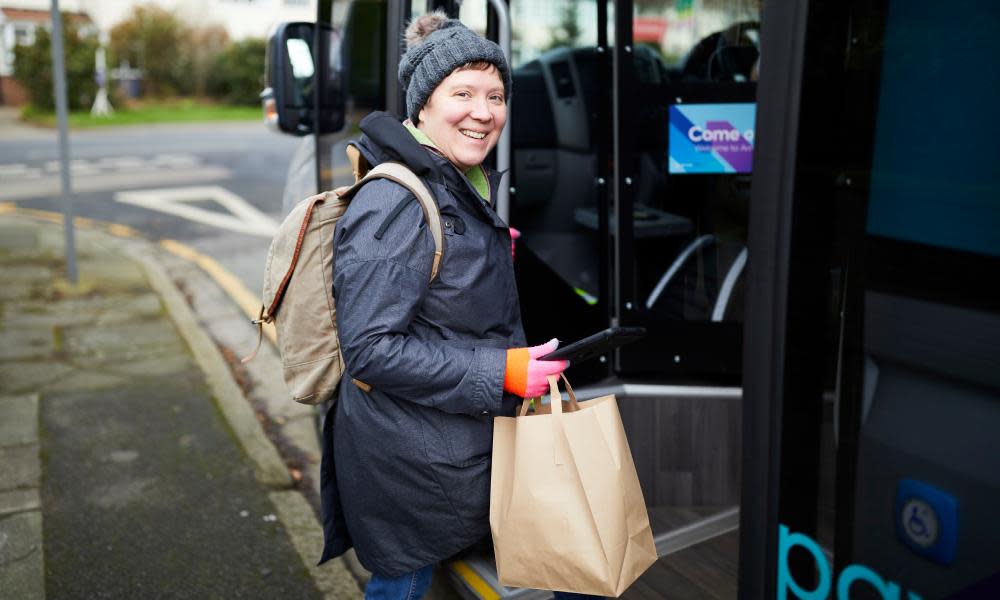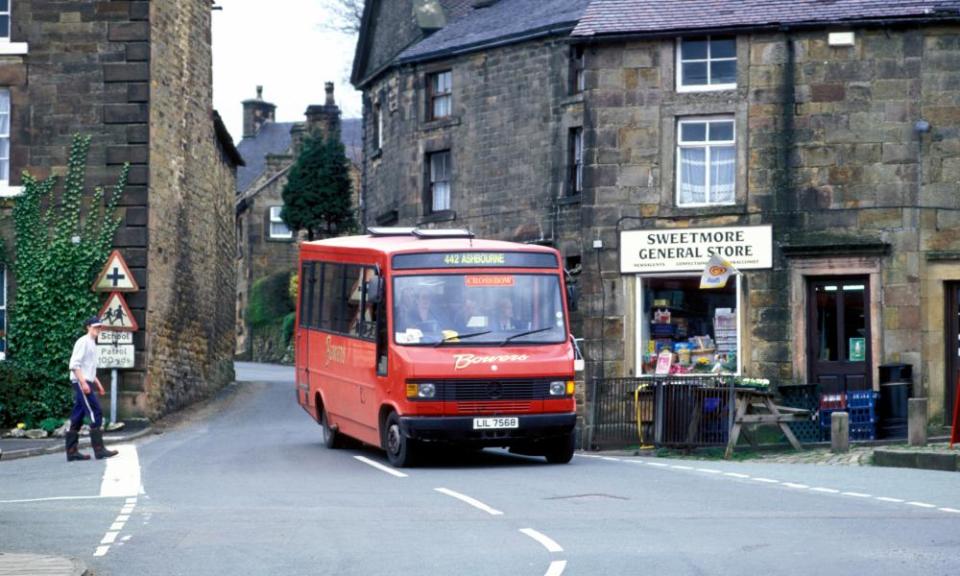When the bus ride to your destination is just a click away

When my dad moved from Birmingham into residential care near my home in Liverpool last autumn, my first consideration – as a non-driver and not-very-good cyclist – was how often I’d be able to visit him. The best home we found for him was a 45-minute walk or a £5 cab ride away, with no direct bus since the hourly council-subsidised service was cut in 2017.
There was a solution at hand: ArrivaClick, a form of “demand-responsive” public transport that I describe to perplexed friends as a cross between an Uber and a bus, and has been running across south Liverpool since mid-2018. You download an app, enter your card details, location and destination, and a few seconds later you’re informed whether there’s a minibus within a five- to 15-minute timescale that can pick you up a few yards from where you’re standing.
The driver follows a route, shown on a GPS-connected tablet, which can deviate slightly to make extra pick-ups of people who are going the same way. Depending on the time of day, I usually find myself travelling with three or four others who have summoned the app at the same time, paying an average of £2 or less per journey. It has enabled me to see my dad every other day and to take him on day trips and to GP appointments at a surgery where the nearest bus stop is a good 10-minute walk away.
ArrivaClick currently runs 25 minibuses around south Liverpool, with plans to add more as the service gains in popularity: downloads of the app are running at 1,000 a week. Yet although it’s been a lifeline for me and my dad, are demand-responsive buses really an alternative to a decent, cheap, regular bus network?
Related: HS2 poised to get go-ahead as £5bn pledged for bus funding
Since 2010, an estimated 3,000 bus routes have been cut in England and Wales, yet buses are suddenly all the rage. When Jeremy Corbyn used his entire allocation of prime minister’s questions to grill Theresa May about bus cuts in 2018 he was laughed out of town, yet 18 months later the government has stolen a host of bus policies from Labour’s 2019 election manifesto. Last week it announced £5bn over five years for restoring cancelled routes, electric fleets, “turn-up-and-go” services as well as creating cycle links for every region outside London, and funding local authorities to pilot their own demand-responsive services.
I spent a week on my usual itinerary of ArrivaClick trips – to my dad’s, the city centre, late trips back from the station and the usual household retinue of checkups, children’s parties and afterschool playdates – finding out how other people use the service. There are regulars like myself who use the service daily – a blind woman with a guide dog who can usually be picked up outside her front door, and a disabled traveller who uses the bus to get to college after another subsidised route was cut.
On the way to my dad’s I meet Jane, on maternity leave and travelling with her baby son to a playgroup in the city centre. She first used ArrivaClick a month ago “for a hen do, which was brilliant, because 10 of us piled on and after the first passenger it only costs a pound per person. I think they expected a limo but we got a minibus!”
I usually use it for work. This has been absolutely great, as I’d be paying for a taxi otherwise
Kim, ArrivaClick bus user
Encouragingly, she now uses the service in preference to her car, “no contest” – as does Dan Feather, a lecturer in history at Liverpool John Moores University. He had been commuting by train, “but the [Northern] train I was using got cancelled so many times” he felt he couldn’t rely on it. “The [Click] fares are so much cheaper.” His colleague, researcher Isaac Scarborough, is a non-driver who lives a decent walk away from a regular bus route. “It’s led us away from using Uber,” he says. “It’s consolidated a lot of things that were less convenient, for instance, we live near a rail station but there are only two trains an hour.”
Kim, on her way to visit a friend near Wavertree Technology Park, explains that a Merseytravel-subsidised bus route that ran through the park was cut in 2018. “I usually use it for work. It takes half an hour to walk, but I don’t finish till half nine or 10 at night and it’s awkward, because I have to change buses – two stops each trip, which is stupid. This has been absolutely great, as I’d be paying for a taxi otherwise.”
Arriva describes the Click service as complementary to existing transport options. But what if you don’t have a smartphone or tablet? Only one of its services, which recently replaced a subsidised circular bus service around the huge south Liverpool estate of Speke, is bookable by phone.
Similar app-based bus services have been trialled in Oxford and Bristol. But do they risk creating “digital exclusion”? Darren Shirley, CEO of the Campaign for Better Transport, thinks not. “I don’t see that much exclusion can occur as smartphones are now so prevalent, even among those in their 80s. If it’s going to work, we shouldn’t organise the service around that group, it has to serve the entire community.”
He adds: “The way we look at demand-responsive transport and where it should be used is where a fixed bus route isn’t going to be commercially viable. If a fixed route wends its way through several villages on the way into town, you have to ask: Would DRT better serve those communities?”

The County Councils Network points out that its members – non-metropolitan local authorities – lost almost half of their funding for bus services in the last decade. This compares with a 19% drop in funding for city regions.
“As a result, buses are almost nonexistent in some of the most rural and coastal areas, while county towns suffer from less frequent and more expensive services compared to cities,” said CCN chairman, David Williams. Unless the funding gap is reversed, DRT will indeed seem attractive to councils without the means to restore lost services.
The question is whether demand-responsive buses can truly compensate for the declining patchwork of expensive, privately run services that have existed outside London since the bus network was deregulated in 1986. Since then, bus use outside the capital has declined by 32.5%, compared with a 99% rise in London, where buses remained regulated.
In Hartlepool, a similar service to ArrivaClick, the Stagecoach-run Tees Flex service was launched last week. Jessie Joe Jacobs, the Labour candidate for the Tees Valley mayoral election, in May, is quoted in the Northern Echo as saying that bus provision outside London needs “a fundamental change, not just a sticking-plaster approach that this glorified taxi service Ben Houchen [the current Tory mayor of Tees Valley] is introducing”.
Even though I live in a big city with a decent bus network, I’ve quickly found I can’t do without what my children call “the clicky bus”. If this forms part of the future of bus travel, bring it on – but don’t let it replace the lot. As with the Beeching rail cuts and the demise of trams, once they are gone you’ll have a hard time getting them back.

 Yahoo News
Yahoo News 
